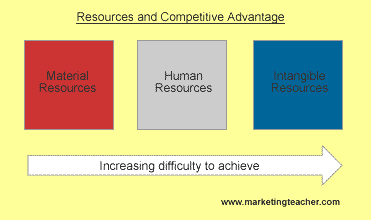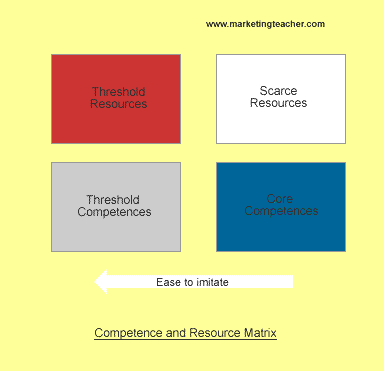Core Competences
Marketing and Core Competences
A core competence is the result of a specific unique set of skills or production techniques that deliver value to the customer. Such competences give an organization access to a wide variety of markets. Hamel and Prahalad (1990) refer to a number of organizations and their products to support their concept including NEC, Honda and Canon.
When trying to identify a core competence, it is often easy to mistake them for scarce or unique resources i.e. resources rather than skills or production technologies. Also often skills and production technologies do not amount to a core competence or resource because they do not comply with one or more of the three tests. They are the thresholds that the organization must achieve to remain competitive. Threshold competences and scarce resources may not provide access to a variety of markets, may not be so significant to customers and may be less difficult to imitate.
In summary there are core competences and scarce resources, and threshold competences and threshold resources.

In order to be competitive an organization needs material resources such as premises, a factory or offices – depending on the nature of business of course. Material resources tend to be the most straightforward to achieve. Then an organization needs to achieve the right balance between Human Resources, training and recruitment. This state is more difficult to achieve. Intangible resources, including core competences are the most difficult and challenging to achieve. This is depicted in the diagram above. In fact they drive competitive advantage.
References.
Prahalad, C.K. and Hamel, G (1990) The Core Competence of the Corporation, Harvard Business Review, May/June.
Stalk, G, Evans, P and Shulman, L, Competing on Capabilities, Harvard Business Review, March/April.
Core competences are interesting from a traditional marketing point of view since it could be argued that they take a product or production orientation rather than a market orientation. If you focus on production techniques and skills then aren’t you looking at your business from an internal point of view? The answer is yes. However, the core competences give a business a competitive advantage in a number of markets, markets where customers perceive a benefit from the product. So if needs are being met better than the competition, there is an argument that core competences are indeed market-oriented. There are at least three tests of a core competence.
Three tests of core competence.
- Provides potential access to a wide variety of markets.
- Should make a significant contribution to the perceived customer benefits of the end product.
- Should be difficult for competitors to imitate.

For example, Microsoft has expertise in many IT-based innovations and technologies. Customers perceive many benefits in relation to Microsoft’s products. For a variety of reasons including unique skills, it is difficult for competitors to imitate Microsoft’s core competences.
